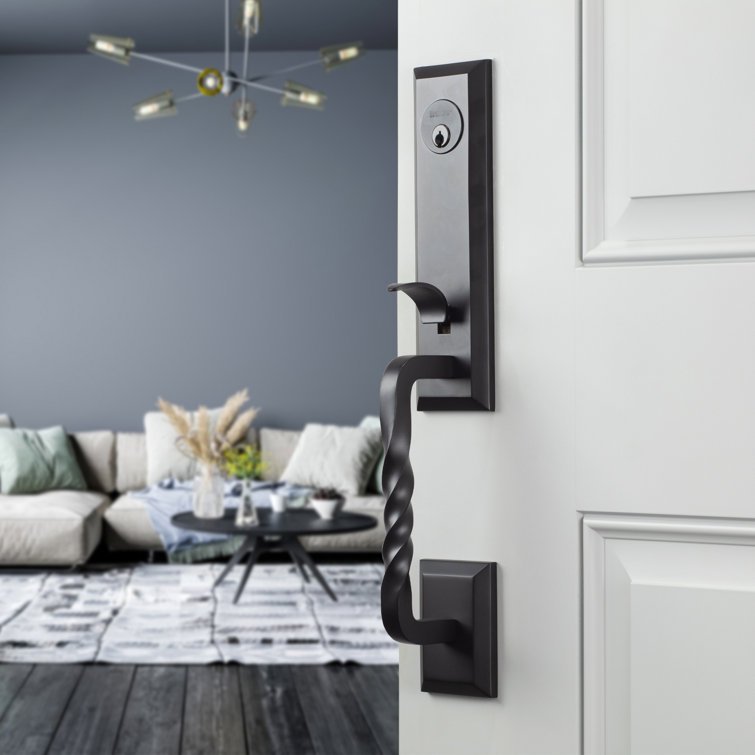
Here’s the thing: fixing a loose handleset rosette isn’t rocket science, and you rarely need a pro to do it. Most people can handle it with a simple screwdriver and a bit of patience. Whether you’re working with a classic round rosette or a modern square design, the basics are the same. And honestly, if you can pair a new TV remote or reset your router, you’ve absolutely got the skills for this job.
Why Handleset Rosettes Come Loose in the First Place
Let me explain what’s really happening behind your door handle. A rosette is that flat, often decorative plate that covers the spot where the hardware meets the door. It holds the handleset steady and hides the unsightly screws or mechanism from view. Over time, though, things shift. Maybe the screws aren’t as tight as they used to be. Or perhaps the wood behind them compresses from constant pulling and pushing—kind of like wearing grooves into your favorite jeans.
Humidity changes can also play a part, especially if you live somewhere with big swings between seasons. Wood expands and contracts, and the hardware shifts, leading to a gap behind the rosette. Oh, and if you ever had to take the handleset apart for a battery swap or code reset, it’s easy to forget to tighten everything down perfectly.
The main culprits:
- Loose or missing screws inside the rosette.
- Stripped screw holes in the wood door.
- Wear and tear from regular use.
- Incorrect installation or over-tightening (which can damage the door or compress the wood).
Don’t blame yourself if it’s come loose—it happens to everyone at some point.
What Tools and Supplies You’ll Need
Before you start unscrewing things, let’s gather what you’ll actually need. You won’t need a full toolbox, but a few basic items will make this go smoothly. Think of it as prepping for a code sync: having the right tools on hand means less frustration halfway through.
Here’s your basic toolkit:
- Phillips or flathead screwdriver (check which fits your handleset screws)
- A small Allen wrench if your model uses set screws
- Toothpicks or wooden matchsticks (to repair stripped screw holes)
- Wood glue for securing loose screw holes
- Paper towel or rag for clean-up
- Replacement screws if any are missing or damaged
On a Schlage or Kwikset handleset, the screws are usually on the interior side, sometimes hidden under a small cover plate. If you’re not sure what brand you have, the paperwork (or maybe even a code stamped somewhere on the lock) can help you figure it out. A little patience here goes a long way—trying to force the wrong screwdriver is a shortcut to scratched hardware.
How to Remove the Handleset Rosette Safely
Here’s where things get hands-on. You might be tempted to just crank the screws tighter, but it’s worth taking the whole rosette off to check what’s really going on. This step is like resetting a remote before you try pairing it—you want a clean slate.
Step-by-step instructions:
- Locate the set screws or main mounting screws holding the rosette in place. These are usually on the inside of the door.
- If your model has a decorative cover, gently pry it off with a flathead screwdriver or a plastic spudger—you don’t want to scratch the finish.
- Once the screws are exposed, unscrew them slowly. Keep a hand on the rosette so it doesn’t drop or mar the door finish.
- Remove the rosette and handle assembly. Set the parts aside on a towel so they don’t roll away or get scratched.
You might notice wood dust, loose screws, or even a bit of corrosion. Take a minute to inspect everything before you move on. This is your chance to spot stripped holes or missing hardware you’ll need to fix before reassembling.
Repairing Stripped Screw Holes
If you found that your screws just spin without tightening, you’ve probably got a stripped screw hole. It’s a classic problem, and honestly, it can be really frustrating. But there’s a super-easy DIY fix that doesn’t involve buying fancy wood filler or calling in a pro.
Here’s how you do it:
- Grab some wooden toothpicks or matchsticks and a dab of wood glue.
- Coat the sticks lightly in glue, then jam as many as will fit into the stripped hole. Snap off any sticking out flush with the door.
- Let the glue dry for at least 15–30 minutes. (Grab a snack! This step matters.)
- Once dry, re-insert your screw. You’ll notice it grabs the new wood and tightens up like new.
This trick works wonders for wood doors and is a lifesaver if your handleset keeps coming loose. If the screw is stripped or damaged, swap it for a new one that matches the thread and length. And if you notice the hardware itself is worn—say, a set screw doesn’t hold—think about replacing it. Most brands, like Kwikset or Schlage, sell replacements that work with nearly any setup.
Reassembling and Tightening the Rosette
Now for the part that brings it all together—literally. Putting the rosette back on isn’t just about cranking down the screws. You want a snug fit, without over-tightening and risking more damage. If you’ve ever tried to sync a remote by mashing all the buttons at once, you know that “tight enough” is a Goldilocks zone—not too loose, not too tight.
Follow these reassembly tips:
- Align the rosette carefully back onto the door, making sure any pegs or anchors fit smoothly in place.
- Insert the screws and tighten them gently at first, alternating sides if there’s more than one. This keeps even pressure on the hardware.
- Once everything feels flush, give each screw a final snug twist. If you see the rosette digging into the door or the plate bending, ease up a little.
- Snap any decorative cover plates back in place, making sure they’re fully seated.
If you notice the handle is still wobbly after all this, double-check that the internal mechanism (like the spindle or latch) is fully engaged. Sometimes a misaligned spindle or out-of-place latch can make things seem loose even when the rosette is tight. It never hurts to pair your effort with a quick visual inspection.
When to Replace Rather Than Repair
You might be wondering if there’s a point where DIY just won’t cut it. Honestly, most loose handleset rosettes are easy fixes. But every now and then, the wear and tear is just too much. Maybe the rosette is dented, cracked, or corroded from years in the rain. Or maybe the internal lock mechanism is damaged—a quick reset won’t fix that.
Here’s when it might be time to replace:
- The screw holes are so enlarged that even the toothpick trick can’t save them.
- The rosette plate itself is warped or broken.
- The mounting screws don’t have anything solid to grab onto anymore.
- The handleset is outdated, doesn’t match your decor, or you want a fresh look (totally valid reason!).
Switching to a new handleset or even a universal model can be as easy as swapping out a remote—just make sure the new hardware is compatible with your door’s thickness and backset. Brands like Kwikset and Schlage offer kits that fit most standard pre-drilled doors, making the process surprisingly plug-and-play.
Tips for Preventing a Loose Handleset in the Future
Once your handleset rosette is back in place, a little proactive care can save you another round of wobbles down the road. Think of it like syncing a remote’s code so you don’t have to troubleshoot every time—you want things to just work.
Simple preventative tips:
- Give the screws a gentle snug check every few months, especially after big weather changes.
- If you ever remove the hardware for a battery swap or code reset, remember to retighten everything on reassembly.
- Don’t over-tighten—just firm enough that nothing shifts when you apply pressure.
- If you notice a new wobble, fix it early before the screw holes get worse.
It’s also worth keeping a spare set of screws on hand, just in case one goes missing during future repairs. Some folks even label their handleset’s tiny screws in an old remote battery case (seriously, it works). That way, reassembly’s a breeze.
Should You Call a Locksmith or DIY?
Here’s where it gets personal. If you’re comfy with basic tools and a little trial and error, fixing a loose handleset rosette is one of those home repairs you can totally handle yourself. You don’t need to know the inner code of your lock or be a pro at troubleshooting—just a willingness to give it a shot. The DIY route is faster, cheaper, and way more satisfying.
But if your handleset has a smart lock feature, complex electronics, or keeps coming loose no matter what you do, calling in an expert might be the best move. Locksmiths have special tools and know how to reset or pair advanced locks so everything works flawlessly. For basic mechanical issues, though, save your money and enjoy the bragging rights.
A loose handleset rosette can make your door feel cheap—but with the right repair, it’s like hitting “reset” on your home’s first impression.
Wrapping Up: Enjoy Your Secure, Sturdy Door
Getting your handleset rosette tight and steady again isn’t some mystery reserved for handypeople or pros. With a little time and some simple tools, you can tackle the problem head-on—no special code, pairing, or advanced troubleshooting required. Next time your Baldwin, Schlage, or Kwikset handle starts to wobble, you’ll know exactly what to do. Give yourself a quick pat on the back every time you feel that solid, reassuring click when you close the door on your newly secure home.
